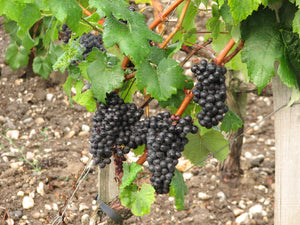Pinotage is a unique grape variety that was first bred in South Africa in the 1920s. It is a cross between Pinot Noir and Cinsault, and it's named "Pinotage" as a combination of its two parents. The grape is a intraspecific crossing rather than a hybrid variety of Vitis vinifera.
For much of its history, Pinotage has suffered from a bad reputation among critics and consumers. However, South African producers have been working to change this with thoughtful viticultural and winemaking processes. Well-made Pinotage wines can range in style from easy-drinking table wines to dense, concentrated wines with aging abilities. The variety is often used in blends, particularly with Cabernet Sauvignon and Shiraz in Stellenbosch.
Pinotage is a hardy and productive grape, but it is susceptible to viral diseases and can be fussy about both terroir and winemaking. The best examples come from bush vines, a form of vine training that is common in southern France, where Cinsault originates. Pinotage typically ripens early with high yields and sugar levels, requiring restrictive vineyard management. The grapes have particularly thick skins which contribute to the wine's tannin.
In terms of winemaking, care is needed during fermentation to prevent the development of acetone-like flavors. Winemakers may restrict skin contact and limit maceration time to mitigate this. In recent years, lighter-bodied Pinotage wines with high acidity from grapes picked early in the season have become popular.
Pinotage is primarily grown in South Africa, but it is also found in small quantities in New Zealand's North Island, parts of California, Brazil, Israel and neighboring Zimbabwe.

